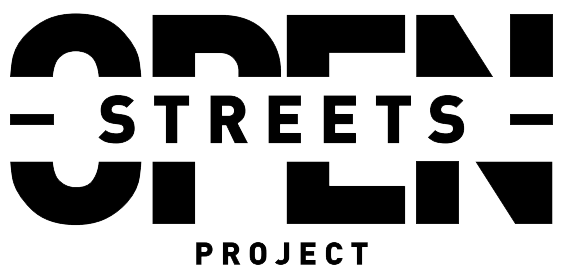About the Money, Money, Money
Let’s talk dollars and cents. One of the biggest challenges for program organizers is finding funding for Open Streets programs. It’s sad but true. While many programs in Latin America are fully government funded, the trend so far in North America is a partnership model where the costs are shared between local governments, non-profit organizations, and corporate sponsorships or donations.

Role of Local Government
To achieve a best practice model of Open Streets it is very important to get your local government to the table. There are many programs in North America that have no government funding and little support, and while this may work in the short-term it is not sustainable and will limit your potential of delivering the healthiest program for your community in the longer term.
There are a number of costs related to an Open Streets program that government may be able to provide in-kind or waive fees for including:
- Barricades and road closure signs
- Permit fees
- Cost of transit detours
- Policing
- Traffic management plan
- Volunteers/volunteer database
- Public notices and distribution costs
- Meeting space for public forums
If your government cannot be involved in the early years, make sure you set an internal goal to get them involved in the future. Be sure to maintain a positive relationship with municipal staff and elected officials.

Finding Funding
Regardless of your potential funder, you will need to pitch your idea and ask for money or in-kind contributions. Make a list of potential funders and identify any corresponding leads (i.e. people on your team who have good relationships with the potential funders). Generally speaking, it is easier to have a few larger sponsors than many smaller sponsors. Each sponsor/funder will require time dedicated to relationship building and benefits (ie. logos on marketing material etc). So be strategic.
Potential funders may include:
- Government/government departments (ie. Departments of Transportation, Recreation, Community Services, Public Health, Planning etc.)
- Local grantmakers and foundations
- Non-profit organizations
- Banks
- Real Estate developers
- Successful local businesses
- Business Improvement Districts/Areas
- Companies with related brands (ie. sporting goods stores, lifestyle companies) (ie. healthfood store)
- Insurance companies

Approaching Funders
Approaching potential funders requires having a strong internal understanding of your goals and key messages for the program, as well as an understanding of the goals and target market of the organization you are pitching the concept to. You also need to establish your team values and ethics, since you many have interested sponsors that contradict your brand. For example, a fast food company may be willing to help fund your program. However, a fast food company also helps contribute to the very health issues your program is hoping to address.

Building a Sponsorship Package
Just like when you are pitching your program to government agencies and local stakeholders, you are going to need a presentation package when meeting with potential sponsors. When developing your Sponsorship Package remember…
- Develop an identity for your program and stick to it (key messages, slogan, logo, etc.)
- Customize each pitch you make to the specific sponsor
- Use numbers: stats, value of exposure, size of reach
- Make your ask early in your meeting with your potential sponsor
- Keep your pitch clear and brief
- You need a presentation AND something to leave behind. Do not just leave a copy of your presentation
- Consider giving potential sponsors a menu of different ways they can participate in your program
- A picture is worth 1000 words! Use them to tell your story
Designing your Sponsorship Presentation
You will obviously tailor your presentation to your needs, but as the very least, be sure to include these 6 sections. but remember to keep things clear and brief.
1. The problem we are trying to solve
- Why your community needs Open Streets
- Show them the numbers! What are the statistics to back up the need
2. Your proposal: Open Streets
- Sponsor’s Connecting to the route (branches, stores, target audience)
- Impressions audience, exposure, PR (think about before, during and after each Open Streets date)
- Opportunity for community and employee engagement
3. This is where YOU (the sponsor) comes in
- Why your brand is a good fit
- The ask: tell the sponsor what you want from them
4. The customized opportunity – what’s in it for YOU (the brand)
- What is it? The values and beliefs
- Where it all began, a brief history of the program
- What Open Streets will look like in your city (map and timeline)
- Add a rendering of what your Open Streets will look like if possible
5. Demonstrate existing energy surrounding Open Streets
- Success of programs around the world (pictures and numbers)
- Success and support for this kind of program in your community (if possible)
- Local momentum for Open Streets (press coverage, expressed support)
6. Closing remarks
- Thank you!
- Contact information
You should always leave a package behind. It may include:
- One-page information sheet about your Open Streets program. Think of it as an ‘Executive Summary” of your Sponsorship Presentation (the problem you’re trying to solve, your program as the solution, who your team is and what you want from the sponsor)
- Budget overview for the program
- Timeline for project implementation
- Formal letter requesting sponsorship
- Other items you believe would be relevant. But keep it brief!
Other Questions to Consider:
What?
- What kind of sponsorship are you looking for from different sponsors? Money? Services in-kind? Programming? Media/exposure? Equipment? Manpower?
- What does a sponsor get in exchange for what you’re requesting?
Who?
- What industries will you target and why?
- What specific people within these organizations are you targeting? Do you have any existing connections or relationships?
How?
- What’s your Open Streets marketing campaign? (How will sponsors increase their exposure?)
- What other ways can your sponsors interact with your program?
What do Sponsors Want to Hear?
- How will your Open Streets program align with their Brand’s objectives and its community
- What will they receive in exposure/increased sales/traffic in exchange for their investment in your Open Streets program.
- That your Open Streets program is led and governed by a strong team. The budget is clear and there is a contingency plan.
- Can the sponsor customize the sponsorship opportunity?
- How will their investment in the program make the sponsor’s brand look good?
Feeling unsure of where to start with your sponsorship package? Take a look at these examples:
- Cyclovia Tucson 2013 Sponsorship Packet
Sponsorship packet for Cyclovia Tucson 2013 Sponsorship Packet. The packet includes a letter of support from local politicians, highlights of past year’s events and sponsorship recognition. - Pensacola Open Streets 2017 Sponsorship Package
- OpenStreets MPLS 2019 Sponsorship Package
- OpenStreets 704 2019 Sponsorship Package



